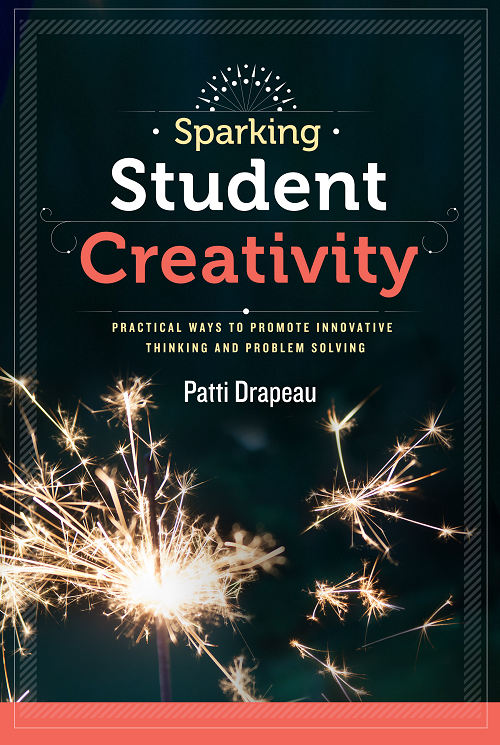In this section you will find units that were developed from the content in Patti’s books. Teachers created units across content and across grade levels. Teachers used a variety of unit design formats to suit their individual needs. Units were developed using the following books: Sparking Student Creativity Practical Ways to Promote Innovative Thinking and Problem Solving; Differentiating with Graphic Organizers Tools to Foster Critical and Creative Thinking; Differentiated Instruction Making It Work; and Great Teaching with Graphic Organizers.
 Sparking Student Creativity: Practical Ways to Promote Innovative Thinking and Problem Solving
Sparking Student Creativity: Practical Ways to Promote Innovative Thinking and Problem Solving
Watch here for sample work to be posted soon!
 Differentiating with Graphic Organizers: Tools to Foster Critical Creative Thinking
Differentiating with Graphic Organizers: Tools to Foster Critical Creative Thinking
The first sets of units are grids with target verbs that are described in detail in Patti’s book Differentiating with Graphic Organizers: Tools to Foster Critical and Creative Thinking. This book not only includes graphic organizers that you can use with these verbs but also procedural language that you can use with your students to help them become better critical and creative thinkers. The book addresses six ways to differentiate using graphic organizers and it has rubrics and rating scales for each verb.
Elementary School Units
- Music, Music Theory, Grade 3, Amy Bouchard
- Language Arts/Literacy, The 39 Clues, The Maze of Bones, Grade 3, by Selina Wing
- Historical Fiction, Grade 5, Susan Sawyer Part1, Part2
Middle School Units
- Science, Matter, Grade 8, by Judy Campbell
- Social Studies, American Revolution, Grade 6, by Michelle Deblois
- Science, Rocks, Grade 6, by Jim Chandler
- Math, Triangles/Congruency, Grade 8, By Anonymous
- Science, Plate Tectonics, Grade 6, by Lynn Ouelette Part 1, Part2
- Language Arts, Fiction, Grade 6, Stephanie Strongin
Secondary Units
- Art, Skills of Drawing, Grades 9-12, by Michaela Lyons
- English, Into the Wild, Grade 10, by Connie Ottmann
 Differentiated Instruction: Making it Work
Differentiated Instruction: Making it Work
The units in the first section utilize the information described in the book, Differentiation: Making It Work. The book describes three tier options for designing tiered questions. Most of the units include the following information: (1) a cover page which describes the set up of the unit; (2) a content page describing the state standards, essential questions, topics, subtopics, themes and generalizations that may be used in the unit and; (3) sets of three tiered questions. In some cases, a unit may include supplemental materials such as rubrics, associated websites, or charts for organizing information. In some cases the author’s name is cited. If the author’s name is not cited, then the author wishes to remain anonymous.
Elementary School Units
- Social Studies, Revolutionary War, Grade 5, by Nancy Connor
- Science, Inventions / Inventors, Grade 4, by Pamela Partridge
- Science, Weather, Grade 4, by Deborah Bartlett
- Social Studies, Colonial Times, Grade 3, by Lois Turner
- Reading, Literacy, Grade 1-3, by Cheryl Morse
- Reading, Title IA Literature, Grade 1-2, by Sue Phillips
- Science, Rainforest, Grade K, by Kelsey MacCabe
- Science, Oceans, Grade 1, by Lisa Truesdell
Middle School Units
- Music, Language of Music, Grade 6, by Cynthia Dineen
- Science, Earth as a System, Grade 6-8 G/T, by Ginny Brackett
- English, The Bronze Bow, Grade 7-8, by Patricia St. Hilaire
- Social Studies, Revolutionary War, 5-6, by Mary Stuart
- ELA, Literature, Grade 6, by Lisa Truesdell
Secondary Units
- Science, Space, Grade 9-12, by Susan Hellewell
- Math, Functions, Grade 10-11
- English, Myths, Legends, Heroes Grade 10, by Patti LeBlanc
- Social Studies, Civil Rights, Grade 12
- Social Studies, Global & Regional Interdependence, Grade 12
- Social Studies, Business Law, Grades 11-12, by Cynthia Dube
- English, Deathwatch, Grade 9
- Life Skills, Adult Daily Living, Grade 9-12, by Kristin Hanlon
- Music, Music Appreciation, Secondary, by Jesse Page
 Great Teaching with Graphic Organizers
Great Teaching with Graphic Organizers
These units consist of grids that utilize critical and creative thinking skill strategies. The decision making, cause/effect, forecasting, planning, and elaboration strategies all come from Patti’s first book Great Teaching with Graphic Organizers or its revised edition. Most of the activities specified on the grids utilize graphic organizers that can be found in the books.
Elementary School Units
- Social Studies, Bill of Rights, Grade 4, by Donna Curtis
- Social Studies, Colonial Life, Grade 3, by Lois Turner
- Social Studies, Communities, Grade 3, by Jan Rollins
Middle School Units
Secondary Units